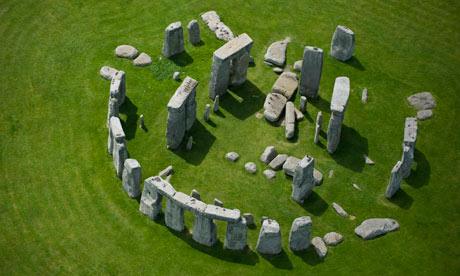The story opens with a completely separate intrigue as our narrator, an unnamed retired psychiatrist, is looking into why Sigmund Freud never received a Nobel Prize, despite having been proposed for the award numerous times. During his investigations in the Nobel archives in Sweden, he stumbles across a 'Crackpot' file full of unsolicited letters, often from people nominating themselves. But amongst these applications is a distinct set of correspondence relating to Stonehenge, which leads our psychiatrist's investigation in an entirely new direction.
 |
| Alfred Nobel |
Florence had married into the family whose land and property included the monument of Stonehenge, which by the end of the nineteenth century had fallen into disrepair. Primarily interested in buying the land surrounding the stones for use in weapons' testing, Nobel and Sohlman pay her a visit, whereupon she takes them on a tour of Stonehenge:
Florence carefully escorted Nobel and Sohlman between the upright and fallen stones, sharing her knowledge of Stonehenge as they proceeded. She particularly wanted Nobel and Sohlman to appreciate the beauty of their surroundings, and described in great detail how the stones changed their colours with the shifting weather. Florence also provided a charming overview of the various theories addressing how Stonehenge had arisen.Nobel is captivated by Florence's performance and indeed by Florence herself. They continue to correspond and her enthusiasm for the stones is infectious, so much so that in one of his final letters, Nobel promises
I now plan to will part of my fortune for the creation of an additional prize - to be awarded to the outstanding man or woman amongst these prizewinners who can solve the mystery of Stonehenge.Sohlman sets about making Nobel's last wish a reality and writes to every Nobel laureate, inviting them to make a submission which will contribute to solving the mystery. Sensationally, the letters which our narrator has stumbled upon in the 'Crackpot' file are entries into this competition from the likes of Ivan Pavlov, Teddy Roosevelt, Rudyard Kipling and Marie Curie.
This is Karlinsky's second novel, following The Evolution of Inanimate Objects which investigates the life of a possible relative of Charles Darwin. Fact and fiction are once again densely woven together in The Stonehenge Letters, which reads less like a story and more like a meticulously investigated historical account, complete with footnotes and documentary support. There are some delightful photographs and illustrations and it's fascinating to realise the connections between the developments taking place in the worlds of science and literature at the beginning of the twentieth century.
Karlinsky captures the analytical tone of his narrator well and takes time to explore the characters of Nobel and his contemporaries, adroitly setting up the background to the fictional prize, so that the novel is about so much more than the mystery of Stonehenge. The potential solutions, not as central to the book as I was expecting, are all absorbing but varying in quality; some seeming almost trite while others are far ahead of their time. I particularly enjoyed the involvement of Einstein in evaluating Marie Curie's submission; this could have been expanded to create an even stronger core to the novel.
While I didn't really recognise the suggestion on the jacket cover that this book is 'laugh-out-loud funny', it certainly does have its wryly amusing moments. Above all The Stonehenge Letters is an intelligent, stylish novel with an original construction and intriguing central premise, which Karlinsky pulls off with great aplomb. By the end of reading it, I was wishing it could all be true; that the Stonehenge Prize really did exist and the letters were today established in pride of place in a Stockholm museum, for us to stand beside in yet another selfie on a well-worn tourist trail.
Thanks to The Friday Project for my review copy.


I shall have to keep my eyes open for this, partly because I am professionally interested in books with unusual structures but also because Stonehenge has been on my horizon this week. I've been teaching the production history of Shakespeare's 'Cymbeline' and there was a version in 1847 that had a human sized model of Stonehenge centre stage. You wonder where they found room to put the actors, especially as there was a full sized Iron Age hut and a large harp to accommodate as well.
ReplyDeleteThat sounds like an extraordinary (and rather unwieldy) set design! Hope you do get to read and enjoy The Stonehenge Letters. I'm planning another visit to the monument this summer...
Delete